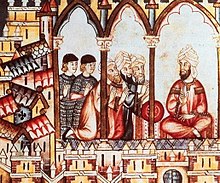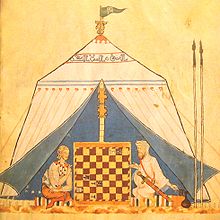Маври



Маври (једнина: Мавар), Мавари или Маури, је назив за исламизоване становнике северозападне Африке, већином номадске сточаре. Од њих потиче име државе Мауританије, чије северне делове настањују. Деле се на неколико племена: Трарза, Бракна, Адрар, Абакак и др.
Маври нису посебан или самодефинисан народ.[1] Енциклопедија Британика из 1911. је приметила да тај термин нема „стварну етнолошку вредност“.[2] Европљани средњег века и раног модерног периода су различито примењивали назив на Арапе и северноафричке Бербере, као и на европске муслимане.[3]
Термин је такође коришћен у Европи у ширем, донекле погрдном смислу да се односи на муслимане уопште,[4] посебно на оне арапског или берберског порекла, било да живе у Шпанији или северној Африци.[5] Током колонијалне ере, Португалци су увели називе „цејлонски Маври” и „индијски Маври” у Јужној Азији и Шри Ланки, а бенгалски муслимани су се такође називали Маврима.[6] На Филипинима, дугогодишња муслиманска заједница, која је претходила доласку Шпанаца, сада се самоидентификује као „народ Моро“, егзоним који су увели шпански колонизатори због њихове муслиманске вере.
Године 711, трупе које су углавном формирали Маври из северне Африке предводиле су Омајадско освајање Хиспаније. Иберијско полуострво је тада постало познато на класичном арапском као ал-Андалус, које је на свом врхунцу обухватао већи део Септиманије и данашње Шпаније и Португалије. Године 827, Маври су заузели Мазару на Сицилији, развијајући је као луку.[7] На крају су наставили да консолидују остатак острва. Разлике у вери и култури довеле су до вишевековног сукоба са хришћанским краљевствима Европе, која су покушавала да поврате контролу над муслиманским областима; овај сукоб је назван Реконкиста. Године 1224, муслимани су протерани са Сицилије у насеље Луцера, које су уништили европски хришћани 1300. Пад Гранаде 1492. означио је крај муслиманске владавине у Шпанији, иако је муслиманска мањина опстала све до њиховог протеривања 1609. године.[8]
Антички Маври
[уреди | уреди извор]У античко доба, Маури је било име једног од берберских племена које је насељавало подручју данашњег Марока и Алжира. Према њима је добила име римска провинција Мавретанија.
У средњем веку, називом „Маври“ или „Мори“ означавао се народ који је настао мешањем античких Мавара с Картагињанима, Римљанима, Вандалима и Арапима. У доба арапских освајања, крајем 7. века, брзо прелазе на ислам. Већина тог старог народа током следећих векова апсорбовани су у арапску нацију.
Мавари на Пиринејском полуострву
[уреди | уреди извор]Почетком 8. века Маври прелазе на Пиринејско полуострво и руше државу Визигота. Освајају готово цело полуострво и заснивају високу културу која опстаје током следећих осам столећа. Почело је кад је група муслимана из северне Африке, на челу са берберским генералом Тариком ибн-Зијадом 711. године заузела Иберијско полуострво и ту своју државу називају Ал Андалуз. То је постао моћан културни и економски центар у коме су цветале уметност и наука. Вековима су се хришћани борили за територијалну превласт и мало по мало освајали територије. 1492. године Фернандо II од Арагона и краљица Изабела I од Кастиље победом у бици код Гранаде, последњем муслиманском упоришту протерују муслимане са полуострва и завршавају шпанско освајање државе.[9]
Хришћани све исламске досељенике називају мориским.
Након успеха хришћанске Реконкисте, која се завршава освајањем Гранаде 1492, већина мориска протерана је у северну Африку. Остали под притиском прихватају хришћанство, али потајно често задржавају своју веру и обичаје. Због тога су изложени бесу народа и прогону шпанске инквизиције.[10]
За њих се, као и за покрштене Јевреје, примењивао погрдан назив Марани (можда према шпанском маранос: гадови, свиње). Касније се тај термин користио генерално за описивање муслимана који су живели у Европи, а од периода ренесансе овај термин се користи за описивање људи са тамном кожом.[11]
Види још
[уреди | уреди извор]Референце
[уреди | уреди извор]- ^ Ross Brann, "The Moors?", Andalusia, New York University. Quote: "Andalusi Arabic sources, as opposed to later Mudéjar and Morisco sources in Aljamiado and medieval Spanish texts, neither refer to individuals as Moors nor recognize any such group, community or culture."
- ^ Chisholm, Hugh, ур. (1911). „Moors”. Encyclopædia Britannica (на језику: енглески). 18 (11 изд.). Cambridge University Press. стр. 812.
- ^ Blackmore, Josiah (2009). Moorings: Portuguese Expansion and the Writing of Africa. U of Minnesota Press. стр. xvi, 18. ISBN 978-0-8166-4832-0.
- ^ Menocal, María Rosa (2002). Ornament of the World: How Muslims, Jews and Christians Created a Culture of Tolerance in Medieval Spain. стр. 241. ISBN 0-316-16871-8.. Little, Brown, & Co.
- ^ John Randall Baker (1974). Race
 . Oxford University Press. стр. 226. ISBN 9780192129543. Приступљено 12. 3. 2014. „In one sense the word 'Moor' means Mohammedan Berbers and Arabs of North-western Africa, with some Syrians, who conquered most of Spain in the 8th century and dominated the country for hundreds of years.”
. Oxford University Press. стр. 226. ISBN 9780192129543. Приступљено 12. 3. 2014. „In one sense the word 'Moor' means Mohammedan Berbers and Arabs of North-western Africa, with some Syrians, who conquered most of Spain in the 8th century and dominated the country for hundreds of years.”
- ^ Pieris, P.E. Ceylon and the Hollanders 1658-1796. American Ceylon Mission Press.. Tellippalai Ceylon 1918
- ^ „Assessment of the status, development and diversification of fisheries-dependent communities: Mazara del Vallo Case study report” (PDF). European Commission. 2010. стр. 2. Приступљено 28. 9. 2012. „In the year 827, Mazara was occupied by the Arabs, who made the city an important commercial harbour. That period was probably the most prosperous in the history of Mazara.”
- ^ Hillgarth, J. N. (2000). The Mirror of Spain, 1500-1700: The Formation of a Myth. University of Michigan Press. стр. 67. ISBN 0-472-11092-6.
- ^ Национална Географија
- ^ Маварска Шпанија
- ^ Национална Географија
Литература
[уреди | уреди извор]- Jan R. Carew. Rape of Paradise: Columbus and the birth of racism in America. Brooklyn, NY: A&B Books, c. 1994.
- David Brion Davis, "Slavery: White, Black, Muslim, Christian." New York Review of Books, vol. 48, #11 July 5, 2001. Do not have exact pages.
- Herodotus, The Histories
- Shomark O. Y. Keita, "Genetic Haplotypes in North Africa"
- Shomarka O. Y. Keita. „Studies of ancient crania from northern Africa.”. American Journal of Physical Anthropology. 83: 35—48. PMID 2221029. 1990.
- Shomarka O. Y. Keita (1992). „Further studies of crania from ancient northern Africa: an analysis of crania from First Dynasty Egyptian tombs, using multiple discriminant functions.”. American Journal of Physical Anthropology. 87: 345—54., .
- Shomarka O. Y. Keita (1993). „Black Athena: race, Bernal and Snowden.”. Arethusa. 26: 295—314., .
- Bernard Lewis, "The Middle East".
- Lewis, Bernard (1982). The Muslim Discovery of Europe. NY: Norton. Also an article with the same title published in Bulletin of the School of Oriental and African Studies, University of London 20(1/3): 409–16, 1957.
- Bernard Lewis, "Race and Slavery in Islam".
- Stanley Lane-Poole, assisted by E. J. W. Gibb and Arthur Gilman. (1888). The Story of Turkey. NY: Putnam..
- Stanley Lane-Poole. The Story of the Barbary Corsairs. NY: Putnam,1890.
- Stanley Lane-Poole, The History of the Moors in Spain.
- J. A. (Joel Augustus) Rogers. Nature Knows No Color Line: research into the Negro ancestry in the white race. New York: 1952.
- Segal, Ronald. Islam's Black Slaves: the other Black diaspora.. NY: Farrar Straus Giroux, 2001.
- Frank Snowden. Before Color Prejudice: the ancient view of blacks. Cambridge, Massachusetts: Harvard University Press, 1983.
- Snowden, Frank (1970). Blacks in antiquity: Ethiopians in the Greco-Roman experience.. Cambridge, Massachusetts: Belknap Press of Harvard University Press, 1970.
- David M. Goldenberg. The Curse of Ham: race and slavery in early Judaism, Christianity, and Islam. Princeton, NJ: Princeton University Press, c2003.
- Lucotte and Mercier, various genetic studies
- Eva Borreguero. "The Moors Are Coming, the Moors Are Coming! Encounters with Muslims in Contemporary Spain." p. „417-32 in”. Islam and Christian-Muslim Relations. 17 (4): 417—32. 2006..
- Arnold, Felix (2017). Islamic Palace Architecture in the Western Mediterranean: A History. Oxford University Press. ISBN 9780190624552. ... – Comprehensive review of palace architecture in Al-Andalus and the Maghreb; slightly more technical than an introductory text.
- Bloom, Jonathan M (2020). Architecture of the Islamic West: North Africa and the Iberian Peninsula, 700–1800.. Yale University Press. – A more recent English-language introduction to Islamic architecture in the region.
- Barrucand, Marianne; Bednorz, Achim (1992). Moorish architecture in Andalusia. Taschen. ISBN 3822896322.. Taschen. . – Overview focusing on architecture in al-Andalus.
- Marçais, Georges (1954). L'architecture musulmane d'Occident.. Paris: Arts et métiers graphiques. – In French; older, but one of the major comprehensive works on Islamic architecture in the region.
- Dodds, Jerrilynn D.,, ур. (1992). Al-Andalus: The Art of Islamic Spain. New York: Metropolitan Museum of Art. ISBN 0870996371.. The Metropolitan Museum of Art. . – Edited volume and exhibition catalogue focusing on architecture of al-Andalus and some related topics.
- Salmon, Xavier (2018). Maroc Almoravide et Almohade: Architecture et décors au temps des conquérants, 1055–1269. Paris: LienArt.. – In French; well-illustrated volume focusing on Almoravid and Almohad architecture. The same author has published other books on Saadian and Marinid architecture.
- Amari, Michele (1854), Storia dei Musulmani di Sicilia (на језику: италијански), I, Florence
- Amari, Michele (1858), Storia dei Musulmani di Sicilia (на језику: италијански), II, Florence
- Gabrieli, Francesco; Scerrato, Umberto (1993). Gli Arabi in Italia. Cultura, contatti e tradizioni. Milan: Garzanti Scheiwiller. ISBN 88-7644-024-0.
- Masson, Georgina (1957). Frederick II of Hohenstaufen. A Life. London: Secker & Warburg. ISBN 0-436-27350-0.
- Previte-Orton, C. W. (1971). The Shorter Cambridge Medieval History
 . Cambridge: Cambridge University Press. ISBN 0-521-05993-3.
. Cambridge: Cambridge University Press. ISBN 0-521-05993-3. - Musca, Giosuè (1964). L'emirato di Bari, 847-871. Bari: Dedalo Litostampa.
- Skinner, Patricia (1995). Family Power in Southern Italy: The Duchy of Gaeta and its Neighbours, 850–1139. Cambridge: Cambridge University Press. ISBN 978-0-521-46479-6..
- Taylor, Julie Anne (април 2007). „Freedom and Bondage among Muslims in Southern Italy during the Thirteenth Century”. Journal of Muslim Minority Affairs. 27 (1): 71—77. S2CID 216117913. doi:10.1080/13602000701308889.
- Buttitta, Antonino, ур. (2006). Les Normands en Sicile. Caen: Musée de Normandie. ISBN 8874393288.
- Aubé, Pierre (2006). Les empires normands d'Orient. Editions Perrin. ISBN 2262022976.
- Lebédel, Claude (2006). Les Croisades. Origines et conséquences. Editions Ouest-France. ISBN 2737341361.
- Lewis, Bernard (1993). Les Arabes dans l'histoire. Flammarion. ISBN 2080813625.
- Musca, Giosuè (1964). L'emirato di Bari, 847-871. Bari: Dedalo Litostampa.
- Previte-Orton, C. W. (1971). The Shorter Cambridge Medieval History. Cambridge: Cambridge University Press.
- Taylor, Julie Anne (април 2007). „Freedom and Bondage among Muslims in Southern Italy during the Thirteenth Century”. Journal of Muslim Minority Affairs. 27 (1): 71—77. doi:10.1080/13602000701308889.
- Santagati, Luigi (2012). Storia dei Bizantini di Sicilia. Lussografica.
Спољашње везе
[уреди | уреди извор]- "The Moors" by Ross Brann, published on New York University website.
- Secret Seal: On the image of the Blackamoor in European Heraldry, a PBS article.
- Encyclopedia - Britannica Online Encyclopedia (2006)
- Khalid Amine, Moroccan Shakespeare: From Moors to Moroccans. Paper presented at an International Conference Organized by The Postgraduate School of Critical Theory and Cultural Studies, University of Nottingham, and The British Council, Morocco, 12–14 April 2001.
- Africans in Medieval & Renaissance Art: The Moor's Head, Victoria and Albert Museum (n.d)
- Sean Cavazos-Kottke. Othello's Predecessors: Moors in Renaissance Popular Literature: (outline). Folger Shakespeare Library, 1998.
